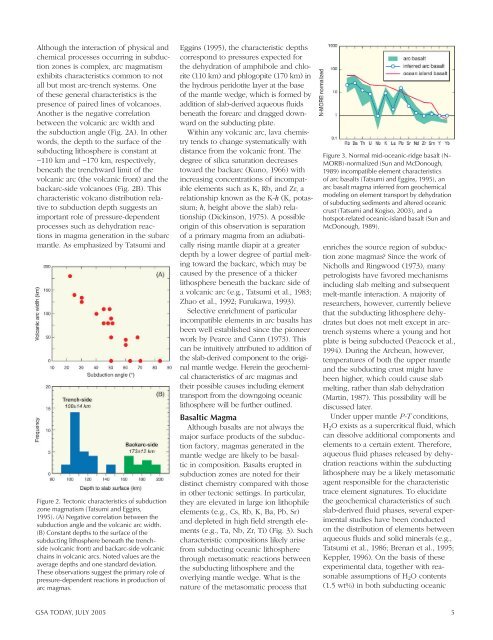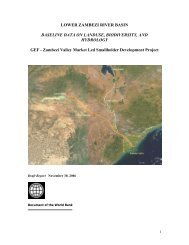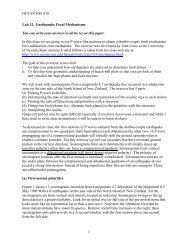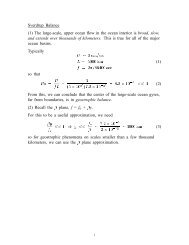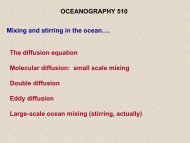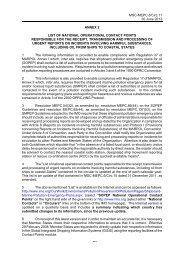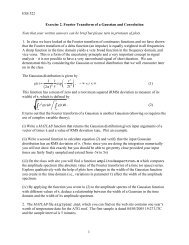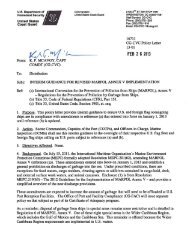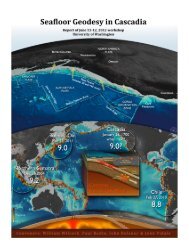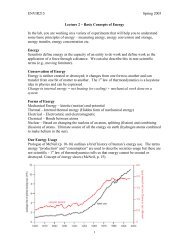The Subduction Factory - Geological Society of America
The Subduction Factory - Geological Society of America
The Subduction Factory - Geological Society of America
You also want an ePaper? Increase the reach of your titles
YUMPU automatically turns print PDFs into web optimized ePapers that Google loves.
Although the interaction <strong>of</strong> physical and<br />
chemical processes occurring in subduction<br />
zones is complex, arc magmatism<br />
exhibits characteristics common to not<br />
all but most arc-trench systems. One<br />
<strong>of</strong> these general characteristics is the<br />
presence <strong>of</strong> paired lines <strong>of</strong> volcanoes.<br />
Another is the negative correlation<br />
between the volcanic arc width and<br />
the subduction angle (Fig. 2A). In other<br />
words, the depth to the surface <strong>of</strong> the<br />
subducting lithosphere is constant at<br />
~110 km and ~170 km, respectively,<br />
beneath the trenchward limit <strong>of</strong> the<br />
volcanic arc (the volcanic front) and the<br />
backarc-side volcanoes (Fig. 2B). This<br />
characteristic volcano distribution relative<br />
to subduction depth suggests an<br />
important role <strong>of</strong> pressure-dependent<br />
processes such as dehydration reactions<br />
in magma generation in the subarc<br />
mantle. As emphasized by Tatsumi and<br />
Figure 2. Tectonic characteristics <strong>of</strong> subduction<br />
zone magmatism (Tatsumi and Eggins,<br />
1995). (A) Negative correlation between the<br />
subduction angle and the volcanic arc width.<br />
(B) Constant depths to the surface <strong>of</strong> the<br />
subducting lithosphere beneath the trenchside<br />
(volcanic front) and backarc-side volcanic<br />
chains in volcanic arcs. Noted values are the<br />
average depths and one standard deviation.<br />
<strong>The</strong>se observations suggest the primary role <strong>of</strong><br />
pressure-dependent reactions in production <strong>of</strong><br />
arc magmas.<br />
Eggins (1995), the characteristic depths<br />
correspond to pressures expected for<br />
the dehydration <strong>of</strong> amphibole and chlorite<br />
(110 km) and phlogopite (170 km) in<br />
the hydrous peridotite layer at the base<br />
<strong>of</strong> the mantle wedge, which is formed by<br />
addition <strong>of</strong> slab-derived aqueous fluids<br />
beneath the forearc and dragged downward<br />
on the subducting plate.<br />
Within any volcanic arc, lava chemistry<br />
tends to change systematically with<br />
distance from the volcanic front. <strong>The</strong><br />
degree <strong>of</strong> silica saturation decreases<br />
toward the backarc (Kuno, 1966) with<br />
increasing concentrations <strong>of</strong> incompatible<br />
elements such as K, Rb, and Zr, a<br />
relationship known as the K-h (K, potassium;<br />
h, height above the slab) relationship<br />
(Dickinson, 1975). A possible<br />
origin <strong>of</strong> this observation is separation<br />
<strong>of</strong> a primary magma from an adiabatically<br />
rising mantle diapir at a greater<br />
depth by a lower degree <strong>of</strong> partial melting<br />
toward the backarc, which may be<br />
caused by the presence <strong>of</strong> a thicker<br />
lithosphere beneath the backarc side <strong>of</strong><br />
a volcanic arc (e.g., Tatsumi et al., 1983;<br />
Zhao et al., 1992; Furukawa, 1993).<br />
Selective enrichment <strong>of</strong> particular<br />
incompatible elements in arc basalts has<br />
been well established since the pioneer<br />
work by Pearce and Cann (1973). This<br />
can be intuitively attributed to addition <strong>of</strong><br />
the slab-derived component to the original<br />
mantle wedge. Herein the geochemical<br />
characteristics <strong>of</strong> arc magmas and<br />
their possible causes including element<br />
transport from the downgoing oceanic<br />
lithosphere will be further outlined.<br />
Basaltic Magma<br />
Although basalts are not always the<br />
major surface products <strong>of</strong> the subduction<br />
factory, magmas generated in the<br />
mantle wedge are likely to be basaltic<br />
in composition. Basalts erupted in<br />
subduction zones are noted for their<br />
distinct chemistry compared with those<br />
in other tectonic settings. In particular,<br />
they are elevated in large ion lithophile<br />
elements (e.g., Cs, Rb, K, Ba, Pb, Sr)<br />
and depleted in high field strength elements<br />
(e.g., Ta, Nb, Zr, Ti) (Fig. 3). Such<br />
characteristic compositions likely arise<br />
from subducting oceanic lithosphere<br />
through metasomatic reactions between<br />
the subducting lithosphere and the<br />
overlying mantle wedge. What is the<br />
nature <strong>of</strong> the metasomatic process that<br />
Figure 3. Normal mid-oceanic-ridge basalt (N-<br />
MORB)-normalized (Sun and McDonough,<br />
1989) incompatible element characteristics<br />
<strong>of</strong> arc basalts (Tatsumi and Eggins, 1995), an<br />
arc basalt magma inferred from geochemical<br />
modeling on element transport by dehydration<br />
<strong>of</strong> subducting sediments and altered oceanic<br />
crust (Tatsumi and Kogiso, 2003), and a<br />
hotspot-related oceanic-island basalt (Sun and<br />
McDonough, 1989).<br />
enriches the source region <strong>of</strong> subduction<br />
zone magmas Since the work <strong>of</strong><br />
Nicholls and Ringwood (1973), many<br />
petrologists have favored mechanisms<br />
including slab melting and subsequent<br />
melt-mantle interaction. A majority <strong>of</strong><br />
researchers, however, currently believe<br />
that the subducting lithosphere dehydrates<br />
but does not melt except in arctrench<br />
systems where a young and hot<br />
plate is being subducted (Peacock et al.,<br />
1994). During the Archean, however,<br />
temperatures <strong>of</strong> both the upper mantle<br />
and the subducting crust might have<br />
been higher, which could cause slab<br />
melting, rather than slab dehydration<br />
(Martin, 1987). This possibility will be<br />
discussed later.<br />
Under upper mantle P-T conditions,<br />
H 2 O exists as a supercritical fluid, which<br />
can dissolve additional components and<br />
elements to a certain extent. <strong>The</strong>refore,<br />
aqueous fluid phases released by dehydration<br />
reactions within the subducting<br />
lithosphere may be a likely metasomatic<br />
agent responsible for the characteristic<br />
trace element signatures. To elucidate<br />
the geochemical characteristics <strong>of</strong> such<br />
slab-derived fluid phases, several experimental<br />
studies have been conducted<br />
on the distribution <strong>of</strong> elements between<br />
aqueous fluids and solid minerals (e.g.,<br />
Tatsumi et al., 1986; Brenan et al., 1995;<br />
Keppler, 1996). On the basis <strong>of</strong> these<br />
experimental data, together with reasonable<br />
assumptions <strong>of</strong> H 2 O contents<br />
(1.5 wt%) in both subducting oceanic<br />
GSA TODAY, JULY 2005 5


